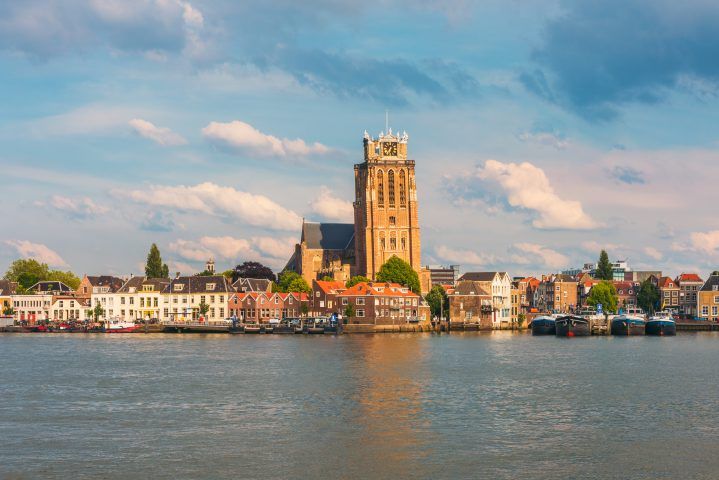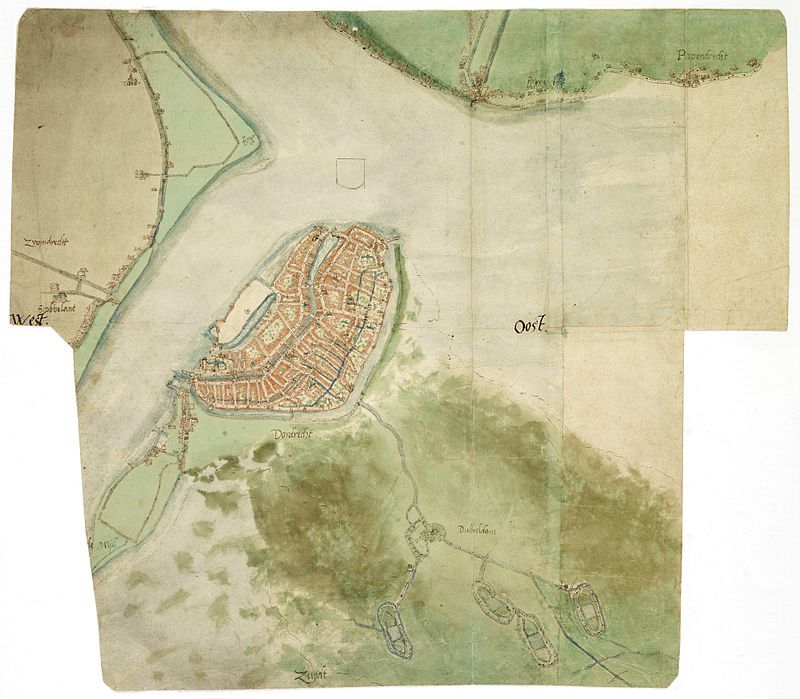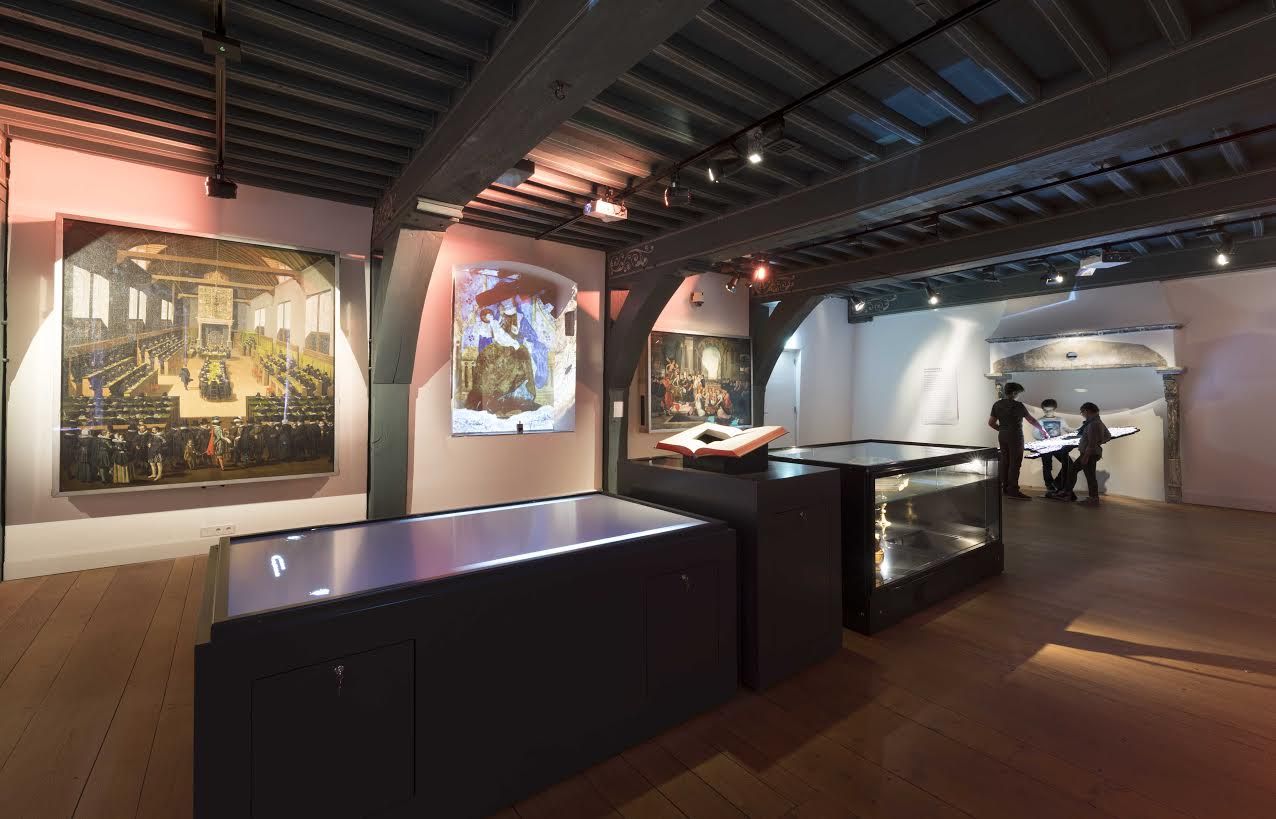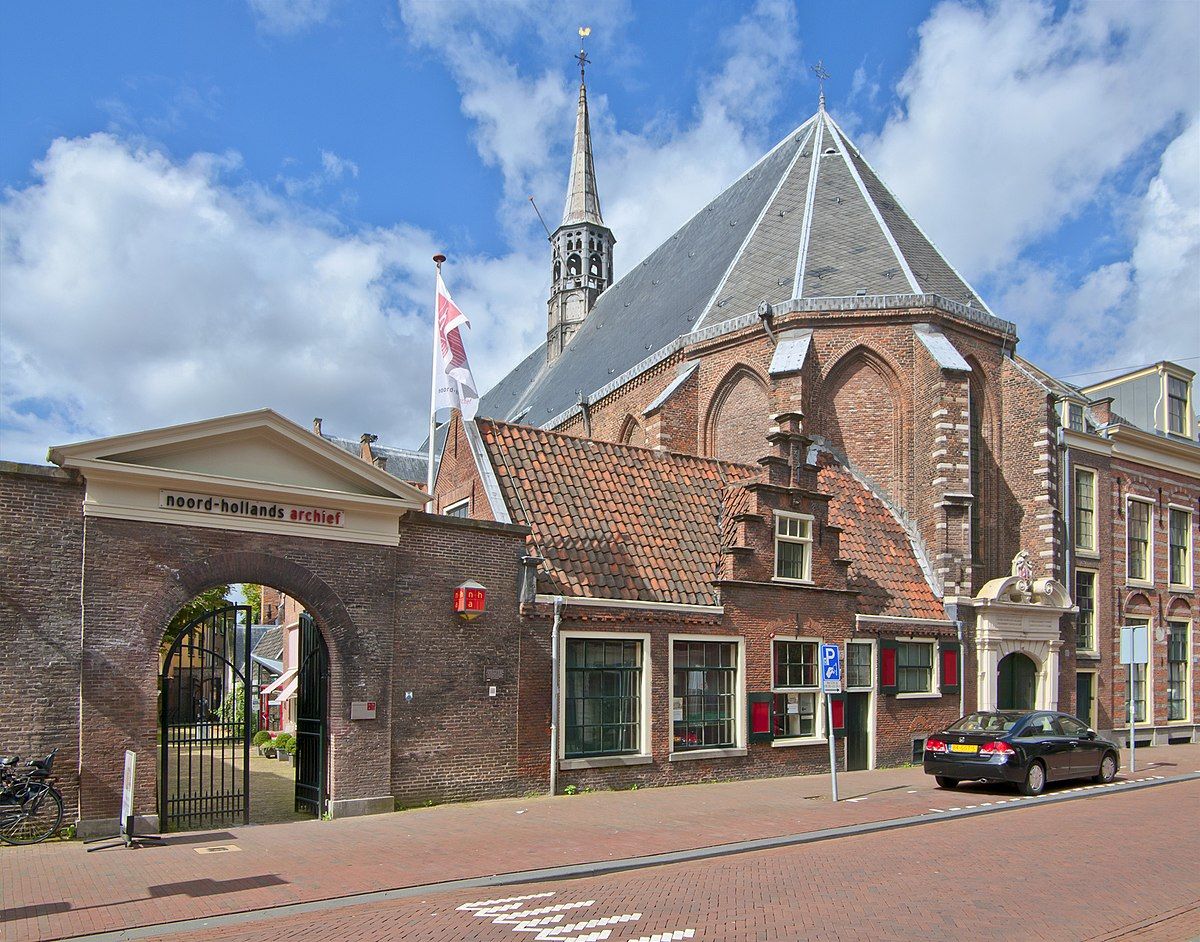Pandora's Archives No. 6|Dutch Court: Between Archives and Museums (Let Love Power Season 2)
"Can you tell me the difference between the functions of the National Archives and the City Archives?"
"The National Archives is the country's archives, and the city archives are the city's archives."
"Doesn't that mean you didn't say anything?"
"A thousand words, why didn't you say anything?"
"Then please spread the word."
"Well, there are so many cities, to start the topic, let's start with Dordreich ."
Summary <br class="smart">Dordrecht: The Island Surrounded by Five Waters, the Old Town During the Ceasefire Age of Religious Wars: The Hague Coup, the Council of Dort, Beheadings and Imprisonment The Dutch Court: the old abbey at the end of the century with the new century museum

The island surrounded by five waters, the old town during the ceasefire
At first glance, Dordrecht looks like other mid-sized cities in the Netherlands, with a well-preserved old town, brick buildings and ubiquitous canals, and a city population of about 120,000 is enough to maintain a certain prosperity. , while not appearing crowded and noisy. However, this ordinary appearance is only for the present, and the city's splendor of yesterday is far more than this. Dordrecht is the oldest city in the two Dutch provinces. In fact, it is an island surrounded by five waters . It enjoys the convenience of water conservancy and shipping.
In this part of the Old Town, Dordrecht today is not much different from the seventeenth century. The Dordrecht Cathedral has been standing on the banks of the Old Maas since it was built in 1470, looking out at the green waters of the wind, and the large and small boats tied to the docks, on the day our story is about to be told, 1618 On August 29, the side of the cathedral should be like this. The midsummer is over, and although the clear sky remains the same, it is indeed getting colder day by day.
At this point in time, the Low Countries have been engaged in the War of Independence for over forty years, even if hindsight tells us that they will continue the war for that long. At this time in 1618, the Low Countries were relatively calm, as the Low Countries, under the leadership of the Dutch ruler Oden Barnefi , signed a twelve-year ceasefire agreement with the Spanish crown in 1609, allowing both sides to take a breather.
Below is a 1565 map of Dordrej showing the island of Dordrej surrounded by waterways . The map is now in the National Archives of the Netherlands.

If on August 29, 1618, there was a foreigner in Dordrecht who was familiar with a bad debt in Europe, he would have seized the temporary tranquility and traveled around the old town, because over the years there had been rumors in the Netherlands that the Prince of Orange, Mo. I am afraid that Rhys Nassau is going to take action against Odenbaneffi. Who knows how long it will be quiet? It is well known that the Prince has always advocated the complete expulsion of the Spanish forces from the Low Countries, and was never happy to see a ceasefire between the two sides. In addition, the Prince followed strict Calvinist teachings and defended the Armenian theory of the Leyden Seminary in Odenbaneffi. Really intolerable. The doctrinal interpretations of these two factions are on the same page, and even lead to violent conflict. Obviously, it cannot last for a long time. Now people are talking about the church meeting of the Dutch Protestant Conference. It is said that the place is in Dordrecht. The Council of the Church (1578) was also held in Dordrecht.
Visitors leave the cathedral on the water's edge and turn to the island to wander around the city. He heard that Dordrecht is also an important printing town in the Netherlands. If he could find one or two printing houses, he would like to visit it, but after half a day he could not enter through the door. before the monastery building, and realized that this was the location of the legendary secret meeting in 1572 .
Looking back at this time in 1618, 1572 was a distant year. Four years before that (1568), cities in the Netherlands rose up against the heavy taxation and religious restraint of the Spaniards, but there was no unified command center for this armed activity, and the autonomous cities went their separate ways. In order to consolidate each other, the cities sent representatives this year to a secret meeting in the oldest city of Dordrecht in the Netherlands, forming the " Dordrecht Alliance " and electing William I, Prince of Orange, as the consul.
Pictured below is the location of the 1572 conclave, a medieval monastery that was later confiscated by the Reformed Church from the Catholic Church. Such buildings are common in the Netherlands and are called " courts " because they have an atrium shared by several houses. This historic court was later given the nickname " Dutch Court " because it was the place where the Dordreich Alliance was formed. Prince William I of Orange, who was chosen to rule here, was the soul of the Revolutionary War and is now called the "Father of the Fatherland" by the Dutch.

Visitors pass through unassuming portals into an open atrium. One can imagine the city representatives meeting in this hidden place in 1572 and signing an affidavit of alliance. That was the first alliance of rebel cities, and other political integrations to follow, before the seven lowland provinces that had been ruled by Spain finally passed the Oath Act in 1581, no longer recognizing the king of Spain as their rightful monarch , and proclaimed the establishment of the United Republic of the Seven Low Countries .
The newly independent republic not only struggled hard, but was struck by the assassination of William I in Delft in 1584. The brutal war continued until a twelve-year ceasefire was signed in 1609. Thinking of Oden Barnefi, who led the ceasefire agreement, tourists also think of the jurist next to the senior ruling, Grosius . It is said that the pamphlet "Freedom of the Seas" published in the year when the ceasefire agreement was signed was written by Grosius, who now holds the title of Rotterdam Salary Consultant and is busy in The Hague, the political center of the Netherlands. He was originally a theologian and jurist from Leiden University. He naturally belonged to the Armenian Defence School in terms of doctrinal interpretation. He was at odds with Maurice Nassau, Prince of Orange. This year, Utrecht Province sent a representative to The Hague to meet the prince. He was also obstructed by Grosius, which is said to have made the prince very dissatisfied.
The Hague coup, the Dort Conference, beheadings and captivity
Visitors leave the medieval monastery in awe, anticipating the rumoured second meeting of Dortmund to take place sooner rather than later. I heard that the church intends to make a decision on the Bible translation work at this meeting. At this moment, there is no unified writing in Dutch. If you decide to translate the Bible, you must first formulate writing standards. That is a first-class event in the history of the Netherlands. If you want to come to Grosius, as an excellent theologian, he will definitely participate. In this conference, debate the doctrine with his unparalleled eloquence, and contribute to the translation with his superb language skills.
Unbeknownst to the visitor, just as his mind was full of wild thoughts, an astonishing coup d'état took place in the inner court of The Hague. At the arrangement of Maurice Nassau, Prince of Orange, Audumba Neffi, Grosius, and their other political ally, Hohebez , were ensnared on charges of treason .
In November of this year, the Dutch Reformed Church held its second Dort Conference at Dordrecht Cathedral. In addition to the representatives of various Dutch denominations, there were also representatives of many foreign reformed denominations. Even England and Scotland have representatives across the sea. Grosius, the theologian who was imprisoned, was of course not present, and it was not important whether he was present or not. Rumors about the synod had spread throughout the Netherlands long before the meeting began. The so-called interpretations of the doctrines of the so-called debates, such as whether redemption has been predetermined, whether people still retain a trace of divine grace in the secular body, etc., are said to be mere agendas on the table, but in fact the conclusions have long been determined.
The picture below shows the second Dortmund Conference held at Dordrecht Cathedral. It was not only a national church conference, but also an international gathering to resolve doctrinal disputes within Protestantism.

The Armenian Defenders will be refuted and rejected, nor will they be tolerated, and they will be completely eliminated from the political arena. Maurice Nassau may not have dared to kill Grosius, but he did not spare the over seventy-year-old ruling Oden Barnefi. On May 13, the year after his arrest, at the dawn of spring, the old man was beheaded in the inner court of The Hague. His last words were: "People, don't believe that I am treasonous. I have always been sincere and pious, good and patriotic, and I will die in this capacity. ”
Grosius, like Odenbaneffi, was passionate about nation-building. With his ingenuity, he contributed a valuable theory of "freedom of the seas" to the newly established republic, and the United East India Company was thus able to capture the dazzling wealth of the East India and bet it on the war of independence. Unexpectedly, the country he loved now accused him of treason. He is also a theologian who pursues tolerance, because the Republic was born to resist religious restraint, and now that the Prince of Orange has put him in prison, it means that the Low Countries have abandoned the religious tolerance they originally pursued. After being sentenced to "eternal imprisonment", Grosius, a theologian and jurist, was sent to the waterway of Louvre Castle, one can imagine the pain in his heart.
In 1621, when Grosius escaped from prison and escaped to Paris, the 12-year ceasefire agreement ended. Without the obstruction of Odenbaneffi and Grosius, the Low Countries were once again engaged in the fight against Spain under the leadership of the Prince of Orange. war. Three years after escaping from Louvre, Grosius published "On the Laws of War and Peace" in Paris in 1625, the same year that Maurice Nassau came to the end of his life. The fate of the two men seemed to mock each other. Of course, visitors to Dordrecht in 1618 would not have known this, but even at that moment, the treacherous and sinister nature of Dutch politics could not be concealed from irrelevant passers-by.
Four hundred years have passed. The Dordrecht Cathedral, which once held church meetings, still stands on the banks of the Old Maas, and the monastery that used to serve as a secret meeting place for revolutionaries earlier still stands in the quiet old town, and because of this former meeting and alliance , and in the last century gained the reputation of " Dutch Court ".

The Dutch Court at the End of the Century and the Museum of the New Century
At the end of the last century, in 1999, a new director came to the Dordrecht City Archives. I heard that the Dutch Court was only occasionally used to hold meetings or events, and most of the time it was idle and useless, which caused a headache for the city government. The historical importance of the Dutch Court was considered as a basis", which suggested possible uses for the site. The proposal is simple and clear, with two main points: first, turn the Dutch Court into a museum and set up exhibitions related to the history of the Dutch Court and Dordrecht; second, relocate the City Archives to the Dutch Court.
The newly appointed curator is our archivistYan Pingshi . He said: "I wanted to move the archives, how good it would be to work there. Later, the city government really adopted my suggestion. The problem is that they are moving around and moving too slowly. When the decision is made in ten years, I will I have left the Dordrecht City Archives and moved to the National Archives in The Hague. As a result, I haven't worked in the Dutch Court for a day."
Although the desire to work in the Dutch Court was not realized, the City Archives moved there after all, sharing this historic space with the Dutch Court Museum. The Holland House Museum is also a good example of implementing the abstract concept of "country" into a space where people can actually experience it, concretely demonstrating the claim that "there is no country outside the place". Yan Plover said:
"Where are we going to find the history of the founding of the country? Of course, the National Archives holds a lot of documents from the sixteenth and seventeenth centuries, but how can the general public have a realistic feeling about the "founding of the country"? I think this is It has to be local. In 1572, representatives of Dutch cities met in Dordrecht, so Dordrecht was a place where anyone could easily experience it. Likewise, one could go to the royal court in Delft The museum , which was the residence of William I, Prince of Orange, was the place where he was assassinated in 1584. The bullet holes in the wall are still well preserved. In addition, Leiden University was the first Protestant university in the Netherlands during the revolutionary era. It was a field where Protestants and Catholic Spaniards competed in knowledge. Isn't Grosius a talent cultivated by Leiden? The Spaniards suffered in his writings, I am afraid it is no less than the battle with William I on the battlefield. confrontation."
The picture below shows an exhibition room in the Dutch Court Museum. The painting on the right wall shows the painting describing the second meeting of Dortmund.

However, having a space full of history is not enough to make the Dutch Court a museum, so Yan Plover suggested in the original proposal that part of the collections of the Dordrecht City Archives be transferred to the future Dutch Court Museum . This part of the collection is related to the Dort conference mentioned earlier. Yan Plover explained:
"The second Dort Conference made a decision to translate the Bible, and it was funded by the state, so this translation, also known as the " National Translation ", was the first time to unify the writing of the Dutch language with the power of the state. Of course it was of great importance to the fighting Low Countries. This translation was published in Dordrecht in 1637, partly because the original meeting was held here, and partly because Dordrecht was the center of the Dutch printing industry at the time. "
The picture below shows the "National Translation" of the Bible published in Dordrecht in 1637. It was the first Dutch Bible and the first attempt by the Dutch to integrate it into writing.

"These Bibles," Yan Plover said with a smile, "finally, as I suggested, they were transferred from the Dordrecht City Archives to the Dutch Court Museum. Now you can see these Bibles when you buy a ticket to enter the museum. Does it make more sense to put it in the archives?"
However, from the perspective of the original thinker, Yan Plover thinks that the Dutch Court Museum is not functioning as he originally expected. According to a report in the Daily Bulletin of South Holland Province last year , the Dutch Court Museum aims to attract 40,000 visitors a year, but for many years less than half of the number of visitors, and experts' assessments believe that the museum is too adult-oriented. It is not attractive to young people, and the environmental design of the museum itself is not friendly enough. For this reason, the city of Dordrecht decided to invest another 500,000 euros for renovation and improvement in the face of the criticism of the council, hoping to increase the number of visitors. increase to 30,000 passengers per year.
"How to design a museum is not the specialty of our archivists." Yan Pluishi shrugged, "I think the museum may not have a deep understanding of that period of history, so it failed to tell a good and attractive story to visitors, although No matter how I think about it, I find this history quite fascinating. The story we just told shouldn’t be too bad.”
The picture below is the underground part of the Dutch Court Museum, and the building itself is quite impressive.

Indeed, what happened around the city of Dordrej, the cathedral and the Dutch Court is a story of the changing circumstances of the religious wars. Yan Plover can only regret that a good idea has not been put to good use, and hopes that after the museum is rectified, it can be Live up to the many precious historical materials transferred by the city archives. However, during our interview, Yan Plover checked the Internet and found out that the city of Dordrej had changed the name of the Dutch Court to the Netherlands Court . This made the Brabant-born archivist so angry that he didn't want to be interviewed.
"The Netherlands is the Netherlands and the Netherlands is the Netherlands. The Netherlands is just one province of the Netherlands - now there are two provinces, North Holland and South Holland. Although historically outsiders have been partial to the Netherlands, Alluding to the habit of the whole of the Netherlands, but the place where the Dordrecht conclave was held was later called the Dutch Court , precisely because the representatives of the Dutch cities were assembled here, and no other provinces participated, until 1581. The United Republic of the Seven Provinces of the Netherlands (Lowerlands) was established in 2009, and only the Netherlands can be said to be a country. The Dutch court was renamed the Dutch court, which means that the Netherlands is enough to represent the whole of Nigeria. Derain, show the arrogance of the Dutch again. They always think they represent everyone in the Netherlands!"
"Maybe it's one of the ways they want to attract more tourists," I speculate in good faith.
"Attracting tourists can't distort history! Originally, I wanted to wish them success in rectification, so that more people would be willing to visit and learn more about this piece of history. Now they are the best..." He paused, thought for a while, and finally shook his head and sighed: "Well, for the honor of archivists, I still wish them a successful reorganization and become a good museum - for the sake of the Bible and historical materials."
"Amen."

Notice of the next issue (after the Lunar New Year)
Searching for the Lost Lake Haren in the Archives of Noord-Holland
The ability of the Dutch to compete with water is unparalleled in the world. A large area of land in North Holland (including the current location of Amsterdam Airport) was originally part of "Lake Harlan", but now "Lake Harlan" is a historical term, no longer seen in For contemporary maps, everything about Lake Haaren can only be found in the archives. After the Lunar New Year, please join us in the Noord-Holland Provincial Archives (above) to find out.
Like my work? Don't forget to support and clap, let me know that you are with me on the road of creation. Keep this enthusiasm together!



- Author
- More